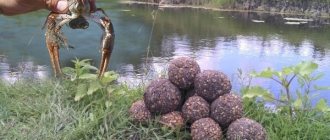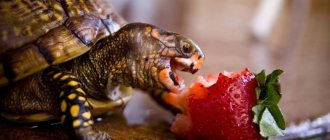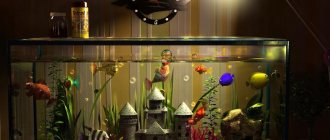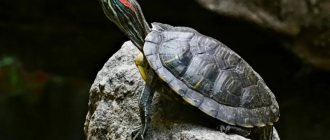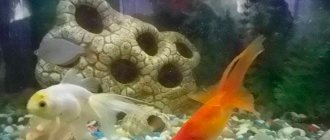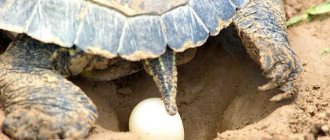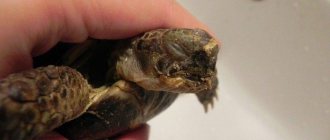We decided to devote this article to a comparison of food items for leopard geckos, since many leopard gecko breeders are rightfully concerned about the question: What is the best way to feed leopard geckos and what food is most beneficial?
Having tried various foods on our charges, we consider crickets to be the best food for constant feeding of the leopard gecko. We do not recommend feeding leopard geckos with fruits, yoghurts and other foods that they do not find in nature, since the reptile’s diet should be as close to natural as possible.
Leopard geckos are quite capricious when it comes to food, and if you feed them all sorts of “goodies”, they very quickly get used to their favorite food and it becomes almost impossible to wean them off it. Therefore, it should be remembered that offering a locust or a hawkmoth caterpillar as a delicacy can then “turn up its nose” for quite a long time even at the food it is accustomed to. Leopard geckos are terrible manipulators, do not let them command you and choose your diet, you must do this, remember, we are responsible for those we have tamed.
Main food
The best food for spotted leopard geckos are various insects. At home, live or frozen crickets and cockroaches are best. In order for the pet to be satisfied with the food offered, the insects must be well fed. Otherwise, no matter how many empty crickets the gecko eats, he will remain hungry in any case. In addition, leopard gecko food must be coated in a nutritious mineral and vitamin supplement before each meal.
Do not offer large quantities of food at once. It’s best to put a couple of food items in a bowl so that you don’t have to catch excess food around the terrarium later. Crickets running around the tank will annoy the baby dragons, bite their tails, paws and molt. It is better not to allow excess food.
When feeding reptiles with frozen specimens, re-freezing should not be used. Moreover, two hours after defrosting, the insect becomes unfit for food.
The main diet of leopard geckos in nature is insects.
If there is no frozen food in stores, then you can buy live insects, feed them well and nourish them, and then freeze them yourself. It is also worth doing if you have doubts about the quality of the purchased live food.
Leopard geckos are real hunters; they absorb everything that moves and moves. It is very important here not to overfeed your pet. If signs of excess weight become noticeable, then high-calorie foods should be excluded from the diet. Young animals should not be fed fatty foods at all, otherwise it will adversely affect their health.
Mealworm
Pros: *Very convenient food - pour it into a bowl, sprinkle it with vitamins and put it in the terrarium. You can forget about the next feeding for several days. *Quite nutritious. It is good to give females during the breeding season as a supplement to maintain good shape. *Very easy to maintain and breed, accessible to everyone. Cons: *May cause obesity or liver disease if fed frequently. *Addictive. *If he runs away, then you can notice black bugs around the house. *Not recommended for freezing.
Treats
Geckos often change their tastes as they grow older. At one time they feed only on crickets, and then categorically refuse them and prefer other food. Therefore, it is better to alternate the menu for adult animals.
For variety, you can offer locusts, hawk moths, moth larvae, zoobass, and mealworms as delicacies. This is a very high-calorie and fatty food; you can pamper your pets with it only a couple of times a month.
After laying eggs, females are given mouse babies - pebbles. This is the most nutritious food that will help restore their strength and replenish nutrients in the body.
Hawkmoth caterpillars are a treat for leopard geckos
Buy spotted leopard gecko, price
When choosing a spotted leopard gecko, you need to pay attention to the following basic parameters:
- the tail part should be quite thick and long, since it is in this part that the main supply of nutrients is contained;
- The sex of a domestic leopard gecko can be accurately determined only at the age of six months, so purchasing a pet earlier may be associated with certain difficulties;
- When visually examining the purchased animal, it is necessary to exclude the presence of scratches and abrasions on the surface of the body;
- eyes and eyelids must be completely healthy, without damage or discharge;
- the toes should be free of old skin remaining after molting;
- the abdominal area should be fairly firm, but not bloated;
- signs of rickets may include excessive thinness, a thin neck, lack of a thick tail, apathy and lethargy, crooked legs, as well as unsteadiness when walking;
- You cannot take a fat animal that has characteristic drooping sides.
It is important to note that baby and juvenile geckos often change color as they grow older, so you should be prepared for a dramatic change in coloration. The cost of an individual, depending on age, varies from one to six thousand rubles
Safe insects
Spotted favorites will eat any insect that appears before their keen hunting eyes. However, not all living things will be useful and safe for them.
The most harmless are crickets, which are sold in pet stores. They are specially reproduced for food, so you don’t have to worry about the quality of such food. You just have to make sure that the individuals are not large, otherwise the reptile’s body will not be able to digest them.
A couple of times a week, leopard geckos can be fed Zophobass as an additional source of nutrition. It is also available in pet stores. There is no need to offer zofobas more often - lizards quickly get used to them, and an excess of such food can lead to obesity.
Silkworms serve as excellent food. However, they are difficult to find and they are expensive. Moreover, silkworms have a short life cycle, so it is not possible to purchase them in reserve.
Zofobas
Pros: *Very convenient food - pour it into a bowl and put it in the terrarium. You can forget about the next feeding for several days. *Quite nutritious. It is good to give females during the breeding season as a supplement to maintain good shape. *Very easy to maintain and breed. Cons: *May cause obesity or liver disease if fed frequently. *Addictive. *Has very powerful jaws and can damage the leopard gecko's internal organs if swallowed. To prevent this from happening, the head of the zoophobass is slightly squeezed. *Not recommended for freezing.
Mineral and vitamin supplements
Calcium and vitamin supplements are a mandatory additional source of nutrients for spotted leopard geckos.
The bowl with the calcium supplement must be placed in the terrarium so that the lizards always have free access to it. With a lack of calcium, reptiles leading a twilight lifestyle develop rickets, which eventually leads to the death of the animal. A sufficient amount of minerals ensures full molting for lizards. Natural sources of calcium such as chalk or eggshells should never be given.
In addition to calcium, leopard geckos also need vitamin supplementation. Insects are first coated in it before being given to lizards. Vitamins for leopard geckos should be purchased in specialized stores. There are no specific standards for vitamin supplements; breeders' opinions on this matter vary greatly. If the leopard gecko eats twice a week, then one of the feedings in the amount of 3-5 crickets must necessarily include a vitamin supplement.
The exception is pregnant women and females after laying. They need more nutrition, respectively, and vitamin and mineral supplements too.
Mineral nutrition (calcium) should always be available in the terrarium
According to herpetologists, Zoo Med supplements are considered the best. The manufacturer produces calcium for reptiles Repti calcium with vitamin D3 and Reptivit vitamins:
- Repti calcium, a phosphorus-calcium supplement used to coat reptile food, has an ideal structure to increase the bioavailability of calcium. You can also pour Repti calcium into a cup and place it in the terrarium.
- Reptivite contains a full range of vitamins and minerals in the correct ratio and should be taken once every two weeks by dipping the food item in it.
One of the best vitamin and mineral complexes for the prevention of rickets in reptiles is Repashy Calcium Plus. This is a complex preparation in powder form, containing calcium in an easily digestible form, as well as a number of vitamins and microelements (AED, retinol, antioxidants, biotin, etc.). The complex is easy to use; you just need to dip the insects fed to the gecko in it every meal. There is no need to use additional sources of vitamins and minerals. "Repash »
contains all the necessary microelements in the right proportions.
Mineral supplements produced in Russia by the Food farm company have also proven themselves well. This is a single drug; it does not contain any other microelements except calcium, so it must be combined with other vitamin complexes. “Food farm Calcium” is presented in several forms: with vitamin D3, without it and in a water-soluble form.
The drug has a very fine dispersion and is well preserved on deboned feed. It is recommended to consume it with each feeding and provide leopard geckos with free access to it.
Repti Calcium
Reptivite
More often you can find JBL products. There are two complexes available in pet stores: Micro calcium and Terravit. They must be mixed in a ratio of 1 (vitamins): 2 (calcium) and rolled in the resulting mixture of insects every time before eating:
- JBL Micro calcium has an ideal grind, the electrostatic charge of the powder ensures reliable attachment to the food object. Perfect for fattening weakened reptiles.
- JBL Terravit provides reptiles with a full spectrum of vitamins and minerals, promotes improved molting, good growth, and eliminates vitamin deficiency.
Tetra supplements are sold in pet stores - Tetra ReptoCal and Tetra Repto Life. These are calcium and vitamins that must be mixed in a ratio of 3 (calcium): 1 (vitamins), rolling the food item in the mixture before each feeding.
However, there are negative reviews about these drugs online, so the decision about which company's products to offer to your pets should be carefully weighed.
JBL Micro calcium
JBL Terravit
Tetra - Tetra ReptoCal
Tetra Repto Life
Golden rules:
- if you are in doubt whether to feed or not, then it is better to skip one feeding;
— if there is no quality food, let your pet starve for some time until you find a suitable one;
— constant feeding of fatty foods (cockroaches and zofobas larvae) destroys the digestive process. Change food periodically, create an assortment;
- only pregnant females can be fed until they are completely saturated, but not more than once every 2-3 days (on average 2-3 zofobas or 3-4 predimago crickets);
— babies up to 1.5 months should be fed once every 2–3 days. The food object eaten at one feeding should not exceed 1/3 the size of the baby’s body size (body size, excluding the tail!);
— all food items (insects) must be up to the pre-mago stage (not fledged, without wings!!!).
Kids willingly eat crickets, cockroaches, and mealworms. However, one should take into account the fact that while the reptiles are growing, the greatest demands must be made on food. It is advisable not to buy insects from dubious sellers, since, according to the experience of many breeders, this can have a negative impact both on the development of growing lizards (it can be very prolonged) and on their health (various types of intestinal infections, worms, chemical poisoning, etc.) in turn also negatively affects their external and internal state).
The most optimal type of food for growing baby geckos is crickets, since, according to many sources, they contain the most optimal ratio of calcium and phosphorus, which is so essential for the healthy growth of young geckos. Of course, a prerequisite for this is that the crickets themselves receive high-quality nutrition with a high content of various vitamins and are kept in conditions adequate for this type of insect. Also during the growth period it is necessary to use additional vitamin and calcium supplements. In some European nurseries, juveniles are successfully reared on mealworms and zoobass. The main condition here is that a calcium mixture is poured into the food bowls, and then worms are placed in it, so that during the meal the pet receives a sufficient portion of calcium along with the food. With this type of feeding, the presence of a bowl with a calcium mixture in the terrarium is necessary and constant. This is due to the fact that, unlike feeding cockroaches and crickets, the combination of phosphorus and calcium in worms is not ideal and, when digested, some of the calcium is removed from the body. Therefore, in this case, it is important to compensate for such an imbalance of elements with additional feeding. However, feeding young leopard geckos is preferable to crickets; in rare cases, cockroaches (preferably Turkmen) or mealworms fed in advance with special calcium supplements can be included in the diet.
It is advisable to always feed geckos at the same time of day. Lizards quickly get used to this time, and this time serves as the main point (peak) of their activity during the day, after which they digest food together in a well-heated place in the terrarium.
An indicator of good health in a baby is: a thick tail, good appetite and active behavior in the evening.
An important period in the life of geckos that is worth paying attention to is the breeding season. During preparation and during the breeding season, it is necessary to increase the proportion of calcium-containing preparations in the diet of female geckos. This must be done because a large amount of calcium is spent on building the shell of the eggs. A lack of calcium causes curvature of the limbs and the so-called “rubber jaw syndrome”, refusal to eat, a general deterioration of the condition, which without professional intervention can lead to unproductivity and even death of the animal, and often even professional intervention does not bring positive results. To prevent this from happening, it can be recommended to roll the food object in a vitamin-calcium composition each feeding and, if possible, feed with insects that contain the maximum amount of calcium - crickets and cockroaches, although it is during this period that many females choose a more nutritious and high-calorie diet. food (zofobas). During this period, it is advisable to feed the geckos daily until they are completely satiated in one meal.
A healthy adult leopard gecko should eat 2-3 times a week, no more often. The lizard should eat at a time until it is completely satiated. Frequent feeding leads to overeating, which causes obesity, and this in turn causes infertility in females, metabolic disorders, and various types of internal diseases. The peculiarity of these geckos is that they are big beggars. They remember quite well those methods of behavior in which they can “beg” food from the owner and can, subsequently, demonstrate them again to receive the treasured delicacy. Therefore, the owner needs to be quite careful in the amount of food he offers and not fall for their tricks.
Usually, an adult gecko accepts all types of insects with great pleasure, although, according to the author’s observation, they still give the greatest preference to crickets, mealworms and zoobass. However, despite their good appetite, sometimes there are individual preferences among some individuals. So, from my own experience, I have more than once observed how some leopard geckos for a long time refused to eat a certain type of food, waiting for another, desired one.
You can also use food to regulate your gecko's weight. Crickets are considered an ideal food source for many representatives of this species. Cockroaches and zofobas contain a higher percentage of fat and are recommended to be given to thin and slightly weakened lizards for quick recovery, unless, of course, the lizard is exhausted due to illness, and crickets are offered to normalize weight.
Also, at any age, vitamin and calcium supplements are necessary throughout the year. Only, unlike young leopard geckos, they need to be given no more than once a week.
You can buy geckos in Kyiv from us (by calling in advance) leopard gecko nursery “Zakharov Reptiles”. You can also buy food insects in our nursery.
feeding a gecko, feeding a gecko, feeding baby geckos, feeding baby geckos, food for baby geckos, feeding a gecko correctly, feeding a gecko correctly, food diet for geckos, food diet for Eublepharis macularius, Eublepharis macularius eating, Eublepharis macularius feeding Eublepharis eating, Eublepharis feeding ,
#Feeding the leopard gecko #feeding the leopard geckos #feeding the leopard gecko #leopard gecko rest #feeding the leopard crickets #feeding the leopard roach #water for the leopard #water bowl for the leublefar
#ZakharovReptiles
50.450100 30.523400
Share this:
- Send this to a friend (Opens in new window)
- Click to print (Opens in new window)
- Click to share on Twitter (Opens in new window)
- Click here to share content on Facebook. (Opens in a new window)
Liked this:
Like
Do they eat vegetables and fruits?
The digestive system of leopard geckos is configured only to digest insect meat. Their digestive tract is short, with an alkaline environment that does not process substances coming from plant foods.
These reptiles lack a cecum, which is responsible for processing cellulose contained in all vegetables and fruits. Theoretically, of course, geckos can eat vegetation, but it will not have the best effect on their health.
Leopard gecko can only digest insect meat
Determination of gender
Sex determination in leopard geckos
The sex of most leopard geckos directly depends on the temperature during egg incubation, which makes it possible to obtain offspring of the required sex with a high probability. The only exception, perhaps, is the Mack Snow morph; unlike other geckos, whose gender is determined by the temperature regime of incubation, this aspect has not been proven in Mack Snow.
So, when purchasing, it is always worth checking at what temperature and for how many days a particular gecko was incubated. Usually a normal breeder will be able to provide this kind of information since most of us usually keep records.
Often, it is possible to reliably determine the sex of a leopard gecko only at the age of about six months. Sometimes there are cases when this can be done earlier. In most cases, knowing the temperature and incubation period, you can be sure with 90% probability that there will be a male or a female.
How to distinguish a male leopard gecko from a female?
Males are larger than females, have a more powerful build, a wide neck, a massive head, a thicker tail at the base with a number of preanal pores (a series of yellowish-brown small dots on the scales between the hind legs) and bulges behind the cloaca.
Sexual maturity usually occurs at the age of 6-9 months, but sometimes earlier and sometimes later.
In leopard geckos, sexual maturity directly depends on their weight. Males become capable of fertilizing a female at about 4-5 months. Sexual activity can be stimulated by 40W overhead heating lamps (the same ones that are usually used in the treatment of rickets). The longer the daylight hours, the more willingly leopard geckos mate.
Females weighing at least 45 grams should be allowed to breed. But as practice has shown, females who have gained 55 grams more easily endure the egg-laying season, and babies are born more active and healthy. If a female becomes pregnant before she is fully formed, this can lead to death, delay or stop of her physical development.
Also, one of the disadvantages of early start in breeding: this can directly affect the quality of eggs, they will die more often, the number of infertiles may increase, etc.
Therefore, if you have firmly decided that you want to try to breed leopard geckos, then you should wait until your pets gain sufficient weight and reach at least 1.5 years of age, this will save you from many problems and dead eggs.
What not to feed
Food for spotted geckos is best purchased from specialized stores or grown yourself. Under no circumstances should reptiles be given insects caught on their own on the street, even in environmentally friendly places.
Wild individuals are carriers of dangerous infections and can also contain dangerous poisons that permeate the environment.
Dead and molting crickets are of no benefit. Dead individuals begin to quickly decompose, and the leopard gecko can become poisoned, and white crickets at the time of molting are completely empty and non-nutritious.
You should not offer your pets vegetables, fruits and other foods that lizards do not eat in nature. Their digestive tract will receive a colossal load, trying to digest something that a priori cannot.
Also dangerous for geckos are insects that glow in the dark (fireflies, beetles). The substance responsible for the illumination is toxic to reptiles. One beetle is enough to cause death.
You should not give your pets insects caught on the street.
Selection and arrangement of a terrarium for the leopard gecko
To be kept at home, the leopard gecko needs a cozy home. The ideal option would be to buy a terrarium. However, it is also considered acceptable to keep a lizard in a capacious plastic container, equipped with everything necessary for a comfortable life for an exotic pet.
Size and material of manufacture
Since plastic containers have cloudy walls, which does not allow convenient observation of the life activity of the leopard gecko, many people opt for a terrarium.
The optimal size of the tank for one reptile is 40x30x30 cm or 35x35x35 cm, for two - 50x40x40 cm. The terrarium should have a rectangular or square shape. Product material: wooden or plastic frame, transparent glass walls. Terrariums with side sliding doors are very easy to maintain.
Temperature
Leopard geckos are cold-blooded lizards that thrive at room temperature. The optimal air temperature in the terrarium is 23-260C.
Lizards, accustomed to moving in the wild on hot surfaces, need warm soil. To heat it, you can use a special thermal mat placed under the bottom of the tank. The heating element should cover no more than 1/3 of the floor area.
There should be an unheated area of soil left in the terrarium so that the pet can independently choose - to bask in a warm place or sleep in a pleasant coolness. The maximum soil heating temperature is 320C. You can control the temperature using a special soil thermometer.
Lighting and heating
Leopard geckos are nocturnal, so natural light during the day will be enough for them. If the terrarium is located in a dark corner, you can equip it with a special lamp with a power of up to 30 W.
To synthesize vitamin D3, the leopard gecko needs ultraviolet light, so an ultraviolet lamp can also be used as an additional light source. But placing the terrarium in direct sunlight is strictly prohibited. Sunlight will strongly heat the walls of the tank, creating an uncomfortable air temperature inside.
A thermal mat is successfully used as a heat source in a leopard gecko terrarium, heating the soil and creating a pleasant microclimate inside the container. As an alternative, you can use a heating cord.
Humidity and ventilation
In a terrarium with a leopard gecko, there must be ventilation holes in the lid or in the side walls of the tank to provide a flow of fresh air.
As for humidity, the optimal value for lizards of this species is 50%. During the cold season, when the heating is turned on in the house, the air becomes excessively dry. To create a comfortable level of humidity in the terrarium, it is recommended to periodically spray the soil with cool water. You can also place a damp substrate or coconut shavings at the bottom of the tank, which humidifies the air well.
To measure the humidity level in the terrarium, use a special device - a hygrometer.
Soil and plants
In order for the leopard gecko to live comfortably in a closed tank, it is necessary to create the right conditions inside the terrarium, close to the natural environment. The bottom of the container is filled with soil. This can be coconut fiber, soft stones and pebbles, large sawdust, tree bark or sphagnum moss.
Some areas can be filled with cleaned and sifted sand, but be sure to observe the lizard's behavior. In nature they do not eat sand, but at home they often absorb it. In such cases, it is better to remove the sand, as it can cause clogging of the stomach and death of the pet.
Special decorative coverings for terrariums are considered the safest for leopard geckos. They are sold in pet stores. Such products perfectly imitate the natural habitat, and they are also easy to clean from various contaminants and are absolutely safe for exotic pets.
You can use live or artificial plants to landscape the area where the leopard gecko lives.
What plants are suitable for arranging a terrarium:
- haworthia subshrubs;
- sansevieria;
- aloe;
- Adromiscus;
- gasteria;
- small species of agave;
- Crassula.
Living plants create a natural atmosphere in the terrarium, stabilize the microclimate and reduce fluctuations in air humidity. Potentially dangerous poisonous plants, as well as cacti and other thorny species of flora, should not be used in interior decoration.
Shelters and decor
Lizards love to hide, so it is imperative to create hiding places in your home terrarium. These can be large stones, bamboo tubes, tree bark and other natural elements. The main thing is to secure them tightly so that a foreign object does not accidentally injure the lizard.
At the pet store you can also purchase beautiful decorative elements and shelters for arranging a terrarium. The assortment includes a large selection: artificial skulls of large animals, caves, grottoes, natural coconut houses, vine trunks, polymer cacti with minks and much more.
Diet
It is best if leopard geckos eat in the early morning or late evening. This mode is typical in their natural environment, because the leopard gecko is a crepuscular reptile.
The age of the reptile mainly influences how often it needs to be fed. There are average nutritional standards for spotted leopard geckos:
- babies under 2 months are given 1-2 crickets every other day;
- young animals aged 2 to 5 months are offered 4-5 crickets every three days;
- young individuals of 6 months of age are given 5-6 crickets, but once every 4 days;
- grown leopard geckos up to a year are fed once every 4 days, 6-7 crickets per serving;
- Adults should feed every 5 days, eating 7-9 crickets at a time.
If your pet has eaten less food, you should not force him to eat the entire portion offered.
Additional treats should be strictly dosed and not given more than twice a month. The exception is females who are pregnant and have laid eggs.
Baby leopard geckos begin to eat from the third or fourth day of birth.
Description of the species
Compared to other lizards, leopard geckos require minimal care.
They have a playful personality and make moves that are fun to watch. Leopard geckos are typically yellow, white, and have black dots. The young are striped and gradually acquire a spotted appearance. There are several colorful and patterned morphs or variations. Some colors are more desirable and valuable, while the typical wild type or normal color is easily available and the most affordable.
View overview
COMMON NAME: Leopard gecko, spotted leopard gecko.
SCIENTIFIC NAME: Eublepharis macularius.
ADULT SIZE: 8 to 10 inches including tails
LIFE EXPECTED: 20 years or more in captivity.
Drinking regime
It is mandatory for geckos to have a cup of clean, fresh, settled water in the tank. The bowl should be medium sized and shallow. Your pet will lap up the water from it with great pleasure, like a kitten. In addition, lizards love to take a bath in such bowls, especially in hot weather. Therefore, the purity of the water in the cup must be constantly monitored and replaced in a timely manner.
Reptiles also love to lick droplets of condensation from a damp chamber. The terrarium can be sprayed with fresh cool water more often - the dragon will happily use its long tongue to remove droplets of water from the walls of its home.
The terrarium must always have fresh, clean water.
General characteristics
Body length: male 25 – 30 cm, female 15 – 25 cm.
Lifespan: male 8 – 10 years. female 6 – 8 years old.
Photo: en.wikipedia.org/wiki/Leopard_gecko
Habitats
The leopard gecko is native to rocky, dry steppes and semi-deserts in Afghanistan, Pakistan, northwestern India and parts of Iran. In winter, the temperature there drops below 10C, causing animals to fall into torpor (hypobiosis) and survive on accumulated fat. The leopard gecko is most active at dusk and dawn when temperatures are most comfortable. These are loners, in nature they live in their own territory.
Characteristic personality traits
Leopard geckos get used to it instantly. They are even able to distinguish the owner from other people. Although leopard geckos are essentially predators, they can be friendly and tame. Leopard geckos are not kept in groups because males show increased aggressiveness towards each other. They are kept either singly or in pairs.
The spotted leopard gecko (leopard gecko) is one of the representatives of reptiles that terrarium keepers are happy to keep. In narrow circles it is simply called “leopard” for its spotted coloring, which makes it similar to this animal. This lizard even drinks water like a cat - lapping it with its tongue. The leopard gecko is popular not only for its extraordinary appearance, but also because even an inexperienced owner can care for it.
Description of the species
In terms of size, the leopard gecko can be classified as a small lizard. The spotted leopard gecko has a massive thick tail, in which it retains moisture under natural conditions. A lizard can easily drop its tail due to some impact on it, then it grows back, but it is shorter and narrower.
The head of the spotted leopard gecko is large and triangular in shape. The entire body is covered with small scales, among which the pimply ones stand out. Paws are thin, with five toes. The leopard gecko's eyes are elongated, convex, and shaped like a cat's.
Color in nature: the body is yellowish-gray with dark spots, a pattern on the tail in the form of transverse rings. At home, the color can be completely different; today, thanks to selection, there are more than 100 varieties of color.
What to do if the leopard gecko doesn't eat
There are several reasons why a leopard gecko refuses to eat. Some of them are normal, others may indicate health problems:
- Changes in living conditions. A newly purchased leopard gecko must get used to its new owner and new living conditions. For animals, as for humans, any significant changes in life cause stress. It is not surprising that the recruit will refuse to eat for the first 2-4 weeks. Don't panic, your pet will soon adapt and his appetite will return.
- Life cycles accompanied by loss of appetite. The annual life cycle of a lizard in the natural environment includes a period of brumation, i.e., going into half sleep. At this time, the reptile becomes lethargic, inactive, eats little or stops eating altogether. This natural process usually continues throughout the cold period of the year until spring. In addition, during the period of active reproduction, many males who are in the mood for mating also lose interest in food. Their instinct at this time is aimed at obtaining offspring, food fades into the background.
- Intestinal blockage. Refusal to feed may indicate constipation of the animal's intestines. This phenomenon causes the lizard to feel full, the newly incoming portion of food is slowly digested, and the geckos do not want to eat. If this situation occurs frequently, it is worth reviewing the feeding regimen. You can help your baby dragon by giving him 1-2 drops of olive oil to lick. A more serious disorder in the gastrointestinal tract is impression. Unlike constipation, it completely blocks the exit of feces from the intestines, the leopard gecko develops intoxication, and the animal may die. This situation requires immediate intervention by veterinary personnel.
- The gecko wanted variety. Spotted leopard geckos are gourmets and picky eaters. They may simply become bored with the food offered by the owner. You need to try to give your pet a new food item or keep him hungry for a while.
- Parasites in the body. Intestinal parasites are the most dangerous enemies of leopard geckos. They not only lead to a decrease in appetite, but also do not allow nutrients to enter the body's cells, causing the animal to lose weight. The presence of parasites is primarily indicated by loose stools with an extremely unpleasant odor. If you suspect the presence of parasitic microorganisms, you must immediately contact a veterinarian and have the animal's feces examined.
Refusal to eat may indicate some kind of blockage in the leopard gecko's gastrointestinal tract.
So, in order to restore the dragon’s appetite, you need to analyze all the above situations. If the pet was bought a long time ago, there is no breeding or brumation season at the moment, you can try to diversify its diet, or let it starve a little.
It is also necessary to adjust the climatic conditions of keeping - geckos' food is digested only in warmth.
If all else fails, you should contact a reptile treatment specialist. Perhaps there are more serious reasons for the lack of appetite.
Types of leopard geckos and features of their behavior
There are five main varieties of the leopard gecko genus: Spotted, Turkmen, Afghan, Iranian and Hardwick's. The most popular are Spotted leopard geckos, which are often kept in special terrariums at home. These lizards have an unusual appearance and are attractive with their beautiful leopard-print coloring.
Spotted leopard geckos are calm and docile pets. They are absolutely not aggressive, quickly get used to people and are very attached to their owner. They make easy contact with small children. Parents should not worry, the smart lizard will not offend the child. They also often ask to be held by their owner and can fall asleep right on the palms of their hands, like cute kittens.
Other types of leopard geckos are rarer inhabitants of home terrariums. Turkmen lizards are a very rare species listed in the Red Book. Iranian leopard geckos are distinguished by their large body size and long legs. Representatives of the Hardwick genus have reddish-brown stripes on their backs. Afghan lizards belong to a subspecies of the Iranian breed.
Leopard geckos have a friendly character, but they do not show it right away. In the first days after purchase, they may seem slightly aggressive, which is associated with stress and adaptation to someone else's home. However, within a few days the lizard will get used to its new habitat and show its kind and flexible character.
In the wild, leopard geckos live alone, but a couple of reptiles can be kept in a terrarium. The main thing is that they are of different genders. Two males will not take root in the same territory; they will constantly fight and divide common possessions among themselves. But two females may well become friendly neighbors.
Mistakes in feeding leopard geckos
Most often, inexperienced owners of leopard geckos make the following mistakes:
- Incorrect feeding time. You should not feed your leopard gecko during the daytime. This is a crepuscular animal that hunts in partial darkness.
- Incorrect temperature in the terrarium. Lizards are cold-blooded reptiles; in order for the food to be digested, the thermal cord and thermal mat in the tank must work properly.
- Offering unsuitable food. Leopard geckos should not be fed worms, maggots and other foods that they do not eat in nature.
- Too many treats and overfeeding. This diet is too heavy and fatty for the gastrointestinal tract, and therefore leads to health problems.
- Feeding with wild insects. Leads to infection of reptiles with infections and intoxication.
- The lack of vitamin and mineral supplements, as well as feeding on “empty” insects, leads to rickets and exhaustion of the animal.
- Activity after feeding. You should not pick up or play with the lizard after eating. In order for the food to be well absorbed, you need to give your pet a good rest after eating.
Compliance with the conditions, rules and feeding regime for leopard geckos will help to avoid troubles with the health of your pet.
Lack of heat slows down metabolism, makes it difficult to properly absorb them and leads to a lack of food
Crickets (house, banana, two-spotted or black)
Pros: *Perfectly balanced food for leopard geckos. *Not fatty, that is, you can feed as much as you like without worrying about the leopard gecko’s health; the animal itself will eat as much as it should. *Thanks to the soft chitinous coverings, crickets are well digestible, and in terms of amino acid content, crickets are even ahead of locusts. *If it escapes, it’s not scary; it doesn’t reproduce autonomously at home. *Can be frozen for future use. Cons: *Quite delicate creatures, especially banana ones. They require strict compliance with the conditions of detention. *Smell, but not strong and not as nasty as some types of cockroaches, regular cleaning helps. *Can cause severe allergic reactions in humans. However, this can be avoided by freezing the crickets after purchasing or purchasing frozen ones.
Cricket Comparison: Types of Crickets
What are the dangers of overfeeding?
Excessive portion sizes, improper diet, and eating heavy, high-calorie foods lead to overfeeding of geckos and their obesity. Overfed animals become lazy, slow, mate poorly or completely lose their reproductive instinct.
Problems with reproduction, gastrointestinal tract, liver and other digestive organs are a small list of troubles that arise from excess fat in reptiles.
Leopard geckos should be nimble, active, restless, with a clearly expressed hunting instinct, but not suffering from excess body weight.
What terrarium temperature does a gecko need?
You can use a regular incandescent white light bulb to provide some warmth during the day. A red, blue or purple heat lamp or ceramic heat emitter can provide extra warmth at night.
Under-tank heating pads work for warmth, but they may not be the most effective at properly regulating your gecko's temperature. If your gecko buries itself on the glass surface of the aquarium, the heating pad may cause burns. Never use hot stones.
As cold-blooded creatures, reptiles must regulate their body temperature. Reptiles like a range of temperatures, or temperature gradient, so they can regulate their body heat.
Provide a daytime basking area at 88 degrees Fahrenheit (31 degrees Celsius), with a temperature gradient to about 75 Fahrenheit (about 24 degrees Celsius).
At night, temperatures can drop to 70 to 75 Fahrenheit (21 to 24 Celsius). Make sure your gecko is not exposed to drafts and do not place the tank near a window or door.
How long can he live without food?
A little hunger is much better than overeating. The lizard's lush tail, which has accumulated a lot of nutrients, will serve as a source of nutrition in the event of even a two-week break in feeding. The reptile's body will feed on reserves from the tail, which will even benefit particularly well-fed individuals.
The tail for a lizard is not only a storage of nutrients, but also a reserve of fat for the winter.
There is nothing complicated or impossible in the rules for feeding spotted leopard geckos. Correct and healthy food, taken according to the regime within acceptable limits, will preserve all the unique external properties, as well as the natural behavioral instincts of these amazing animals. By following all nutritional recommendations, your pet dragon will always be healthy, alert and active.
Have you kept a leopard gecko? Share your secrets of feeding baby dragons with beginners in the comments.
Keeping spotted leopard geckos alone, in pairs, in families, in groups
I remind you of the 2 basic rules for keeping spotted leopard geckos.
- Together we keep females of approximately the same age (for individuals up to a year), size and weight. Kids, teenagers and adults - always separated!
- We keep males one by one.
Male leopard geckos are territorial animals and will become very aggressive if there is a rival. The easiest consequence will be the loss of a tail or bite wounds on the body. Male babies, already at the age of 4 months, should be separated from their sisters or other immature females, since around this time fights for territory begin and the males are already able to impregnate the female.
Female leopard geckos are mostly sociable and sociable creatures, so they can be kept in small groups. Naturally, the temperament of each individual is different, so watch the behavior of your leopard geckos - whether there are any fights, rivalry, or biting. Find out from the seller of the lizard whether it lived in a group or was kept alone. Accordingly, this way you can guess how your pets will get along in the same territory.
If the females have become friends, they will very touchingly sleep together, practically in an embrace, nose to nose, help each other shed, arrange a common toilet, and behave more actively.
Is it safe for a married couple or family group to keep leopard geckos permanently? From my experience I can say that this largely depends on the temperament of the male. The recommendations are usually as follows: for one male you should keep 3-5 females, otherwise he will simply torture his girlfriend with high sexual activity, there will be fights and wounds. I advise you to adhere to this recommendation, but if you want to try to bring a couple or three leopard geckos into a family, try it, just be careful to (you never know) intervene in time.
I can share my very successful experience - 2 families live peacefully and cheerfully on my farm. In one there is a male and 2 females, inseparable for 2.5 years, together they gave birth to two seasons of beautiful babies. In the second - a young couple with a very active male and a very temperamental female - about six months old.
Reproduction
Reproduction of crickets occurs when the insects create comfortable conditions and an abundance of food. In a population, there must be at least 4 females per 1 male, otherwise deadly struggles and deafening crackling are guaranteed. A small container (4 cm deep) is placed in the container, into which wet peat, sand or plain soil is placed. Soon the females will lay their eggs here. To avoid destruction of the clutch by males, this container should be covered with a fine mesh or strainer. Soon the larvae will appear, which after a few molts will become adults.
Raising crickets at home is a fairly simple task. The main thing is to create suitable conditions - temperature, humidity and refreshment, and then give your pets the required amount of food: dry and wet. Females are quite undemanding to conditions, so very soon the population will begin to rapidly increase.
Buy spotted leopard gecko, price
When choosing a spotted leopard gecko, you need to pay attention to the following basic parameters:
- the tail part should be quite thick and long, since it is in this part that the main supply of nutrients is contained;
- The sex of a domestic leopard gecko can be accurately determined only at the age of six months, so purchasing a pet earlier may be associated with certain difficulties;
- When visually examining the purchased animal, it is necessary to exclude the presence of scratches and abrasions on the surface of the body;
- eyes and eyelids must be completely healthy, without damage or discharge;
- the toes should be free of old skin remaining after molting;
- the abdominal area should be fairly firm, but not bloated;
- signs of rickets may include excessive thinness, a thin neck, lack of a thick tail, apathy and lethargy, crooked legs, as well as unsteadiness when walking;
- You cannot take a fat animal that has characteristic drooping sides.
It is important to note that baby and juvenile geckos often change color as they grow older, so you should be prepared for a dramatic change in coloration. The cost of an individual, depending on age, varies from one to six thousand rubles
How to keep leopard geckos healthy?
As long as they are given the right food, care, attention and an appropriate environment, geckos are generally free of problems. Providing warmth, food and vitamins is the most important aspect of their care to avoid long-term problems.
This species will be colorful, have a dense tail, strong legs, and will also be active in foraging at night. It was previously thought that reptiles could carry diseases that could infect humans. This is true for all animals, including dogs and cats, and it is no exception when it comes to reptiles. Personal hygiene is just as important for reptiles as it is for all other types of pets. Pet owners should always wash their hands after handling the animal, and pet food bowls should be washed separately.
Naturally, all lizards lose their skin, which comes off in small pieces. Sometimes you should help them get rid of their skin. This helps them gain access to the moist area. This action may involve providing the terrarium with moist moss to help them shed their old skin. This is especially important if it becomes noticeable that the skin is peeling around the eyes or legs.
